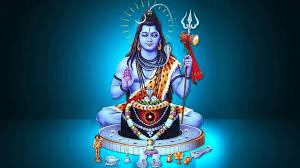Introduction
Shiva is one of the best known gods in Hindu stories. Many people call him Mahadev or the great god. This article tells the shiva story in a clear and warm way. I will share simple facts and small tales you can enjoy. I write as if I speak to a friend. The shiva story shows how change and calm can live together. You will read about Shiva’s family, symbols, dances, and teachings. I also share how people celebrate him today. Each part is short and easy. By the end you will know the heart of the shiva story and why he matters. I will also share small tips to remember the key lines. Books and songs can help you recall the best parts. I add short examples so the tales feel near and real.
Who is Lord Shiva?
Lord Shiva is a central figure in Hindu faith. He is both destroyer and restorer. People see him as calm and fierce at once. Shiva wears simple clothes and sits on mountains. His hair holds the Ganges river. A crescent moon sits on his head. He has a third eye that can see truth. Many call him Mahadeva, Rudra, or Nataraja. The shiva story often shows him meditating and dancing. These tales teach deep life lessons in a simple way. Children and elders alike enjoy these stories. Shiva’s calm presence comforts many hearts. Devotees find courage in his stories. His life asks us to balance work and rest. He is a teacher through his calm and through his fierce acts. People watch his stories to find courage in hard times. His simple life in the mountains inspires many to love close to nature.
Origins and early legends
Many stories try to explain where Shiva came from. Some speak of him as eternal and beyond birth. Other tales link him to ancient Vedic gods like Rudra. Legends grew over many years across South Asia. Different regions added new details and local color. The shiva story mixes myth, poetry, and human hope. Poets wrote about his long hair, his blue throat, and his moods. Old temples and carvings helped spread these tales. Stories passed from elders to children around fires. This made the shiva story rich and varied. Even now people learn about Shiva from many simple stories and songs. Over time the tales arrived in many languages. They mixed with local folk tales and handy lessons. This made each retelling feel like a small new song.
Shiva’s family and relationships
Shiva is not alone in the myths. He is married to Parvati, a gentle and strong goddess. Together they are a loving pair in many tales. Their son Ganesha is a bright elephant-headed god. Kartikeya, their other son, is brave and a war leader. Parvati helps show Shiva’s human side. She softens his fierce ways in many stories. The shiva story often shows these family scenes. They teach duty, love, and play. These tales remind us of care and forgiveness at home. Families read or sing these stories during festivals. Many temples show the whole family in warm art. Children often laugh at sweet family scenes in these tales. Elders smile at the wise acts of the parents. This mix of play and depth makes the myths strong.
Symbols and iconography
Shiva’s images carry deep meaning. He holds a trident called the trishul. A small drum, the damaru, sits in his hand. A snake often wraps his neck like a scarf. His throat is blue after he drank poison for the world. The crescent moon and the Ganges flow from his hair. He wears ash and a simple tiger skin. A shiva story will explain each symbol gently. The trident can mean past, present, and future. The third eye shows inner sight and truth. These symbols help people remember lessons and feel close to him. Temples show these marks in carvings and in paintings. Teachers use these images to speak about deep truths in short words. They work well in short plays for kids and in quiet temple talks.
Shiva’s forms and names
Shiva has many names and many faces. People call him Mahadeva, the great god. Nataraja shows Shiva as a cosmic dancer. Ardhanarishvara shows him as half man and half woman. Rudra is an older, storm-like form. Bholenath means the simple and kind lord. Shankar is a name that means bringer of peace. The shiva story often changes to fit the form. A dance tale will teach rhythm and change. A quiet meditation tale will teach calm and care. Each form helps people find one that fits their heart. Stories help us feel how wide and kind he can be. Across regions, his many names show how people relate to him. Simple songs use each name. These names help folk teach small lessons to children.
Shiva and the Ganges
One famous shiva story tells how the river Ganga came down. King Bhagiratha worked hard to bring Ganga to earth. The river fell from the sky with great force. Shiva caught the river in his hair to slow her. He let Ganga flow gently to the land below. This act saved cities and fields from flood. The story shows Shiva’s care for life and people. It also shows how strength can protect what is soft. Many pilgrimages follow the path of Ganga’s flow. The tale lives on in songs and temple art. Sculptors carved the dance in temple walls. Musicians wrote songs to match the steps. The dance links mind and body in art and prayer.
The cosmic dance: Tandava and creation
Shiva’s dance is a powerful image in many tales. As Nataraja, he dances the cycle of life. Tandava can mean creation, preservation, and destruction. Each step makes and dissolves the world in myth. The dance shows that change is natural and ongoing. Art and music borrow this image to show life cycles. The shiva story uses this dance to teach people about time. People feel small and hopeful when they watch the dance idea. Temples carved the dance in stone for many centuries. The dance keeps the story alive and moving. Dance schools and music groups study these moves. The idea of rhythm helps people feel connected to the whole world. That rhythm lives in many arts and in many hearts.
Shiva and Parvati: a loving bond
Many stories show a deep bond between Shiva and Parvati. Parvati is both gentle and brave in the tales. She chose to tame the wild side of Shiva with love. Together they balance silence and action in the myths. Their life gives many sweet family scenes in stories. The shiva story often uses these scenes to teach love and duty. Parvati asks Shiva to be present at home and in the world. These tales show teamwork and care in simple words. People feel close to the couple in temple art and songs. They inspire people to love with steady kindness. Children often laugh at sweet family scenes in these tales. Elders smile at the wise acts of the parents. This mix of play and depth makes the myths strong.
Shiva in festivals and worship
People celebrate Shiva with joy and deep prayer. Maha Shivaratri is a night many keep awake to sing and pray. Pilgrims visit ancient temples and light lamps. Many fast and chant simple mantras for inner peace. Devotees anoint the Shivling with water and milk as a sign. During the month of Shravan, people give special offerings to Shiva. The shiva story is often told during these holy days. Songs and dances bring the tales to life in towns. Temples host stories, music, and warm food for visitors. These events keep the stories passing to the next generation. Many wear beads and swing small bells on the path. Street stalls sell simple sweets and flower garlands. These scenes make festival days feel warm and alive.
Shiva’s lessons for daily life
Shiva’s tales hold simple lessons for how we live. They teach balance between work and stillness. They teach that anger can be tamed by love and calm. The shiva story often ends with forgiveness and change. His life asks us to accept both loss and joy. Shiva’s meditation shows the value of quiet and inner work. His blue throat shows self-sacrifice for the greater good. These lessons help in small and big moments each day. People use the stories to teach children right from wrong. They also use songs to keep the lessons warm and clear. Try to pause two minutes a day to breathe and be calm. Share a small act of kindness to follow Shiva’s gentle example.
Modern retellings and art
Today artists retell the shiva story in many ways. Writers make simple books for children about his life. Filmmakers and cartoonists bring scenes to new screens. Painters find fresh color and new shapes for old scenes. Dancers keep the Nataraja steps in stage shows and schools. Social media shares short videos of temple art and music. These retellings keep the tales friendly and near. They also help young people feel the old myths. Modern art can focus on kindness, balance, and care. It can also spark new questions about meaning and life. Across the world, people learn and adapt the tales. Libraries and small museums also keep paintings and old books for study.
How to read a Shiva story respectfully
These stories matter deeply to many people. Approach them with gentle curiosity and respect. Listen to elders and temple keepers who know the songs. Read versions by trusted authors and translators. Avoid mocking or changing sacred parts without care. If you retell the shiva story, do it with love and truth. Share why the tale touched you and what you learned. This shows respect and builds trust with readers. Ask teachers when you are unsure about a detail. Respect helps the stories live on kindly for everyone. Kind words and wonder keep the tales strong. If you write about these tales, add a note about where you learned them. This simple act shows care for the culture.
Frequently Asked Questions
What is the main message of the Shiva stories?
Shiva’s tales teach balance, change, and inner calm. They show that life moves through creation and endings. Many stories ask us to face hard times with steady heart. They also teach selfless acts and care for others. A simple lesson is to mix action with rest. Shiva’s quiet meditation shows how stillness brings clarity. At the same time his dance shows how change can also be beautiful. Families use these stories to teach respect and kindness. These lessons are easy to try in daily life, even for kids. The tales help us grow without fear of change.
Is Shiva a creator god?
Shiva is part of a larger process that includes making and ending. He is often seen as destroyer and restorer. Other gods or forces are also linked to creation in the myths. In many tales the three main forces are Brahma, Vishnu, and Shiva. Each has a role: one makes, one sustains, and one transforms. This works like clearing old branches to help new growth happen. So while Shiva is not only a creator, he plays a key role. His power helps make space for new life and new stories. This idea helps people accept endings as chances for new starts.
Why does Shiva have a third eye?
The third eye stands for inner sight and truth. It is a symbol of wisdom beyond what the two eyes see. When the third eye opens it can burn away false things. Many tales use the eye to show discipline and inner power. It also reminds people to look within before they judge. The symbol asks us to seek quiet and honest thought. Teachers use this image to explain focus and deep seeing. It is not a tool for anger alone, but for clear vision. This symbol appears in art and in simple stories for young readers.
What is the symbolism of the Shivling?
The Shivling is a simple, smooth stone or form used in worship. It stands for endless energy and an inner meeting point. Some say it unites the active and the quiet parts of life. It is a focus for prayer and for making offerings. People use water, milk, and flowers as gifts to the lingam. This helps them remember unity and balance in life. Temples keep lingams in central halls for many to visit. While it looks simple, it carries deep spiritual meaning for many. Respectful use helps people feel calm and focused in prayer.
How is Maha Shivaratri celebrated?
Maha Shivaratri is a sacred night of prayer and song. Many people fast and keep vigil through the night. Temples hold special puja with bells, lamps, and readings. Devotees chant simple mantras to find inner peace. Some walk far to visit a favorite temple or holy river. The night honors the divine balance between stillness and change. Families and friends often gather to share stories and food. Music and dance can bring the tales to life in towns. This event helps people renew their faith and sense of service. Children learn simple songs and give small offerings.
Can anyone tell a Shiva story?
Yes, stories are for everyone when told with care. It is best to learn from true sources and wise teachers. Share why the tale matters to you and what you learn. Avoid changing sacred parts without understanding and respect. If you retell a story, credit where you learned it. Use simple words and keep the message clear for young listeners. Ask elders if you are unsure about details or customs. Good sharing can build bridges across ages and cultures. In this way the old tales stay alive and kind for all listeners. Respect and wonder make good storytelling.
Conclusion
Shiva’s tales are old and live in many hearts today. They teach us balance, courage, and kind strength. Through symbols, dances, and family tales we learn. These stories offer clear ways to face change and fear. If you read with respect, the tales can guide daily life. Try one short story with a friend or a child this week. Ask what lesson you both saw and how to use it. Share songs or make a small drawing of a symbol you liked. This simple action keeps the wisdom moving to the next generation. Thank you for reading. I hope these tales bring you calm and courage. If you want, ask me for a short tale to share with a child or friend. I will give a clear version to read aloud.









